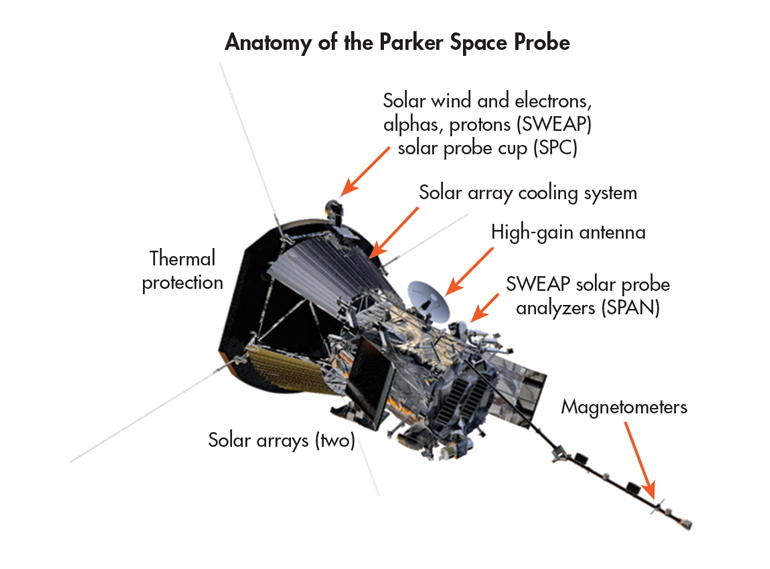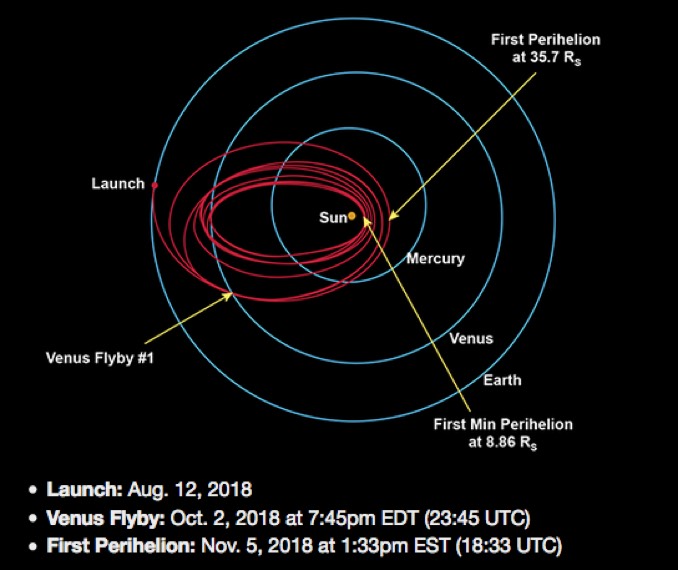What is the Parker Probe?
The Parker Probe is a NASA-launched robotic aircraft which has been designed to probe the atmosphere of the sun, i.e. the solar corona, thus providing the closest observations of the star till date. It was announced in 2009 and launched on 18th August, 2018 from Cape Canaveral Air Force Station in Florida, USA on a Delta Heavy IV rocket. The mission costs 1.5 billion USD.
The Probe was designed and built at John Hopkins University in Maryland, USA. It is named after Eugene Parker, an astrophysicist who theorized the existence of supersonic solar wind and predicted the Parker spiral – the shape of the solar magnetic field in the outer solar system.
Why is this mission being carried out and what are its implications?
The corona is plasma that surrounds the Sun and other stars. It extends several million kilometers into space. Unlike with other celestial bodies, the temperature rises as we move away from the surface of a star and into its corona. The sun’s corona is millions of degrees hotter than its surface. NASA calls this phenomenon the “coronal heating problem”. This high temperature also cause solar flares and coronal mass ejections. None of these phenomena have been clearly understood and determined so far due to the lack of data about the corona. Understanding how the corona works will help scientists anticipate dangerous space weather storms which can disrupt the power grid on Earth.
The aim of the Parker Probe mission is to collect data on the sun’s corona in order to
- Trace how heat and energy flow through the corona and accelerate solar wind
- Determine the forces and mechanisms that cause flow and acceleration of energetic particles
- Determine the structure and dynamics of magnetic fields at the source of solar wind
How will the Probe function?
The probe will perform four suites to study and image the aforementioned energetic particles, fields and solar wind. It will perform five major operations:
- Electromagnetic Fields Investigation (FIELDS), to measure electric and magnetic fields, radio waves, plasma density and related energy/power parameters.
- Integrated Science Investigation of the Sun (ISoIS),to measure energetic electron, protons and heavy ions.
- Wide Field Imager for Solar Probe (WISPR), which will use optical telescopes to image the corona and the heliosphere.
- Solar Wind Electrons Alphas and Protons (SWEAP), which will count the subatomic particles and measure their properties.
- Heliospheric Origins with Solar Probe Plus (HeliOSPP), which will attempt to theorize ways to maximise the efficiency and results of the mission.

The probe will repeatedly use Venus’ gravity through seven fly-bys to gradually adjust its angle and trajectory to shorten its orbit and make it closer to the sun over the course of 6 years and 321 days, after which the ship will run out of fuel and move away from its orbit and start to naturally dismantle. At its closest approach, the speed of the probe will be 700,000 kilometers/hour and its distance from the surface will be 6.2 million kilometers.
Of the 24 solar fly-bys, the first will occur on 5th November, 2018.
On-ship instrument testing will commence in September and the first observations will be recorded in December.
The probe has been adhering to the determined timeline in achieving structural and procedural milestones and has been releasing necessary instruments and establishing required systems. The FIELDS suite has been powered up.

How will the Probe deal with the extreme temperatures?
The probe has employed a custom heat shield – called the Thermal Protection System (TPS) – coupled with an autonomous system. The TPS is 8 feet in diameter, made by sandwiching a 4.5 inch thick layer of lightweight carbon foam core between two panels of a carbon-carbon composite. The sun-facing side of the TPS is sprayed with a specially formulated ceramic to reflect as much of the sun’s energy as possible. This enables the payload to remain at room temperature while the temperature of the shield reaches about 1370 degrees Celsius.
The Probe carries a memory card that stores the names of about a million people and photos of Eugene Parker and the entire study carried out by him in 1958 about the importance of solar physics.

